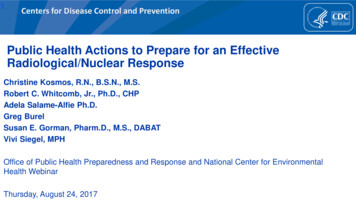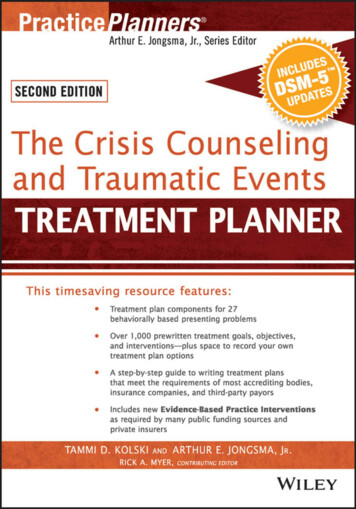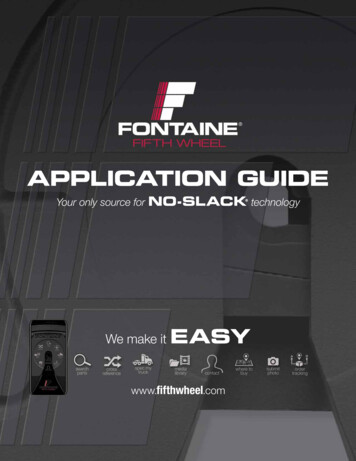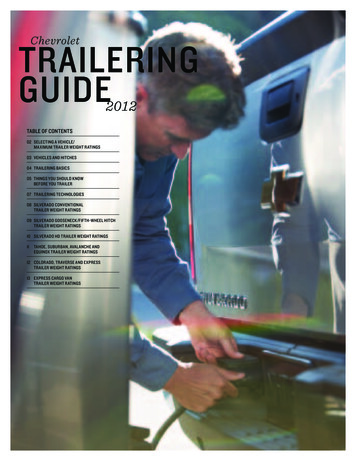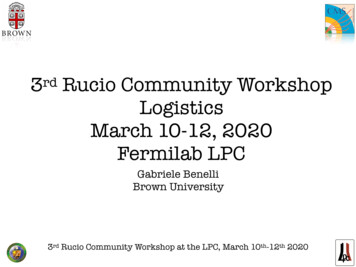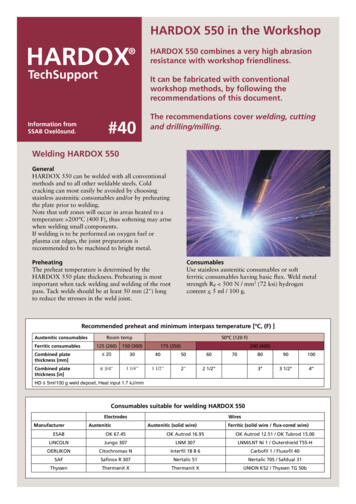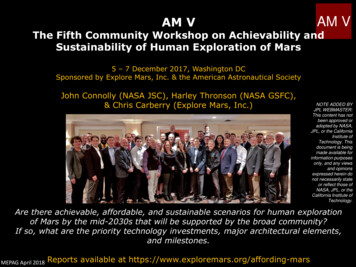
Transcription
AM VAM VThe Fifth Community Workshop on Achievability andSustainability of Human Exploration of Mars5 – 7 December 2017, Washington DCSponsored by Explore Mars, Inc. & the American Astronautical SocietyJohn Connolly (NASA JSC), Harley Thronson (NASA GSFC),& Chris Carberry (Explore Mars, Inc.)NOTE ADDED BYJPL WEBMASTER:This content has notbeen approved oradopted by NASA,JPL, or the CaliforniaInstitute ofTechnology. Thisdocument is beingmade available forinformation purposesonly, and any viewsand opinionsexpressed herein donot necessarily stateor reflect those ofNASA, JPL, or theCalifornia Institute ofTechnology.Are there achievable, affordable, and sustainable scenarios for human explorationof Mars by the mid-2030s that will be supported by the broad community?If so, what are the priority technology investments, major architectural elements,Minimal Architectureand milestones.H2MMEPAG April 2018Reports available at https://www.exploremars.org/affording-mars
Workshop Background, Motivation and DeliverablesAM VOver the past few years, NASA and multiple other organizations have produced a largenumber of plausible scenarios for human exploration of Mars in the 2030s.The fifth Achieving Mars invitation-only workshop (AM V) developed three distinctly differenthuman Mars exploration architectures based on three different “end states.” Subject matterexperts identified areas of commonality, as well as areas where opinions differ andimportant decisions need to be made among the three.Deliverables: Community-developed common architectures for human exploration of Mars inthe 2030s, along with options and alternatives.A community-based assessment of achievability and sustainability of differentcurrent scenarios for human Mars exploration in the 2030s, especially elements ofdifferent Mars architectures that are seen to be divergent among the half-dozen existingscenarios.Findings and observations on viable common elements of different architectures,priority near-term actions, and investments to ensure achievability of these elements andtheir importance in a sustainable human exploration program.Commentary on elements of the different architectures that are not in common.The role that a small number of venues could/should play in assuring achievability andsustainability: ISS, cis-lunar space, the lunar surface, Mars orbit, Martian moons . . .Engagement plans to the general public and stakeholdersMinimal ArchitectureMEPAG April 2018H2M2
Human Mars Mission ContinuumAM VThree different “end states” for human exploration of Mars were adopted asrepresentative of the goals widely identified and an architecture wasdeveloped that sought to achieve each of them under common ground rulesand constraints.ApolloShort SortieExtended SortieMissionsArchitectureGroup 1: SortieClassConjunction-classsorties to differentsitesLong-stay sortieswith infrastructurebuildupArchitectureGroup 2: ScienceField CampPermanentHuman Base,Expedition CrewsColonizationArchitectureGroup 3: TowardsPermanentHabitationInitial exploration analogous to the Apollo Program or the Lewis and Clark “Corps ofDiscovery” Semi-permanent base or “field camp” on the Martian surface, analogous to earlyMinimal ArchitectureAntarctic exploration Building toward sustained, permanent habitation analogous to current AntarcticexplorationMEPAG April 2018 H2M
AM VGuiding Workshop Assumptions and Ground RulesThe three teams, both during the workshop and over the months that followed, developedand critiqued the three architectures in detail that achieved the three end states. They wereguided by a handful of ground rules and assumptions: The initial human mission to the vicinity of Mars will take place by about the mid-2030s. SLS and Orion will be available during the time period considered here, so will not beassessed in depth in this workshop. Early and focused technology investment will be identified, including precursors anddemonstration missions. Partnerships (international, industrial, commercial, academic) will be an essentialcomponent. The role of lunar surface operations with astronauts and robots will be assessed. The role of a cislunar habitation and operations facility will be assessed. Community engagement will be essential. Research and development will continue on ISS at least through the mid-2020s. Budgets available for human exploration of Mars will be assumed to grow approximatelywith inflation. If additional funding appears to be required above that, plausible sourcesof the funding will be identified. No technological “miracles” or, if so, clearly identify and justify them. In addition to major exploration timelines and milestones, major elements of theMinimal Architecturearchitecture and an annual and total cost for each of the three architectures arepresented in the final report.MEPAG April 2018H2M4
Architecture Group 1: Sortie-class MissionAM V Mars orbit-only mission in 2033 Separate robotic sky crane mission would deliver 1 tunpressurized rover with science equipment- Could be controlled from Earth for site characterization- Could be teleoperated from Mars orbit- Would serve as unpressurized rover for the landing crew 1ST two-week landing sortie in 2037 2ND two-week landing sortie in 2041 3RD and following missions could include cargo landers,habitats, and/or pressurized rovers and other equipment Flight rate could potentially be increased to a new crew everyMars opportunity Program could expand to add more cargo landers, have H2Mlonger stays, on-ramp new technologies, and build up a baseMinimal ArchitectureMEPAG April 20185
Two-Week Mars Surface Sortie Mission ConceptAM Vcrew of 4; 5 SLS launches; 5 commercial launchesMarsCrewlanderComplete set of mission elementsMAV to LMOLMO 2 week surface stay125 kWeSEP TugMAV-to-HMOboost stageMAV-to-HMOboost stageMAV-to-HMOboost stageAerobraketo LMOBoost stageCrewlanderMAVMAV to HMOHMOAerocaptureintoHMOInject toMars 1.5 yearsMOICrewLanderDSHMOI TEIStage StageLoiter inHEO 250 daysEDS 250 daysTMITotal round trip 950 daysOrionEUSCommerciallaunchEUST -2yearsT -2.5yearsT -3years1EarthMEPAG April 2018T -1year23Departure stagefor crew landerTEI 450 daysCommercialdeliveryCrewlaunchT -6monthsT -30days54Could possibly be acommercial deliveryAcronyms:DSH Deep Space HabitatEDS Earth Departure StageEUS Exploration Upper StageHEO High Earth OrbitHMO High Mars OrbitkWe kilowatts, electricLMO Low Mars OrbitMAV Mars Ascent VehicleMOI Mars Orbit InsertionSEP Solar Electric PropulsionTEI Trans-Earth InjectionTMI Trans-Mars InjectionHEOLEOEntryH2MMinimal Architecture6
Six Vehicles to Enable Crewed Missions to MarsAM V# Vehiclesper MissionProduction Rate11 every4 yearsIn developmentSLS51.25 peryearIn developmentSEP Tug11 every4 yearsStudies areon contract11 every4 yearsStudies areon contract41 peryear11 every4 yearsVehiclesOrion 125 kWeDeep SpaceHabitatIn-Space ChemicalPropulsion StageMars LanderMEPAG April 2018Could be malneedArchitectureto start7
Architecture Group 2: Mars Field Station ArchitectureAM VBreakout Group 2 developed a mission architecture to deploy a temporary field station on thesurface of Mars from which the crew would conduct scientific research. This work builds ondesigns developed as part of NASA’s Evolvable Mars Campaign (EMC). The AM V teamre-examined this architecture to incorporate more commercial/international participationand consider integrating technology demonstration and operations development in cis-lunarspace.An essential characteristic of this architecture is the demonstration of the feasibility ofhuman occupation of Mars, beginning with a series of missions starting with roboticprecursors and technology development in LEO and at the Moon.After the necessary robotic recon and support infrastructure have been deployed,equipment and eventually crews of up to six people will journey to the surface. Thesefirst missions to the surface of Mars will be carried out over the course of a decade and will helpdemonstrate both the strengths and limitations of our equipment, con-ops, and even ourlanding site.The architecture is defined by the flexibility of the approach. For example, to reduce long-termexpenses, the architecture phases in more efficient technologies as they are developed asMinimal Architecturefunding is available. One example is nuclear thermal propulsion, a technology notimplementable in the near term, although necessary for sustainable human occupation.H2MMEPAG April 20188
Architecture Group 2: Mars Field Station ArchitectureAM VPrimary objectives of this mission architecture included Learning how to live and work sustainably on the surface of MarsDeveloping and testing the technologies required for future longer-duration habitation onthe surfaceDefining the desirable characteristics of an exploration zone in preparation for future humanactivitiesEvaluating the viability of biology (human, agricultural, or extant microbes) on the surface,andPerforming priority science to understand the martian environment and the effects of longterm habitation in space and on the surface on human healthH2MMinimal ArchitectureMEPAG April 20189
Architecture Group 3 :“Towards Permanent Habitation” Utilizes a set of Guiding Principles which result in permanent presence--- Architecture is really a plan for how to proceed with developments and missions toenable permanent presence at some point in the future, within reasonable NASA,international, and commercial crewed exploration budgetsFlexibility is designed in to accommodate incorporating what has been learned witheach mission, funding changes, and a fluid set of commercial and internationalpartnersIntended to be a permanent long-term campaign of exploration, with timelines thatadjust based on many factorsThe goal of permanent human presence results in a number of keyarchitecture differences, as compared to the other AM V architecture groups.Some key differences include:-- AM VFlexible mission objectivesHeavy emphasis on utilizing local resourcesProtection against failure modes to ensure mission successMartian surface treated as dangerous until mastered MTV is treated as the safe haven Mission sequence builds from orbital missions throughshort stays to permanent presenceSix person crews with three person landers/MAVsEmploys a 3-phase campaign to establish a Permanent Surface BaseMEPAG April 2018H2MMinimal Architecture
Architecture Group 3: Campaign Phases(1) Reconnaissance MissionsAM V(2) Initial Human Presence in Orbit & SiteSelection SortiesH2MMinimal ArchitectureMEPAG April 2018(3) Surface Infrastructure Emplacement
Human Mars Architecture Points of Agreement/Points of DepartureAM VH2MMinimal ArchitectureMEPAG April 201812
Points of Agreement: Architectural Design DecisionsCommon to All Architectures The destination should be the Martian surface – preliminary missions to cislunar space, lunar surface, Venus, flyby ofMars, or Phobos missions were considered unnecessary. All teams agreed that the first surface mission should be flown nolater than 2037.All missions should be flown using Conjunction Class trajectories. The long-duration stay in the martian system waskey to the exploration objectives, and even the Apollo-class architecture that only planned to stay on the surface for 14 solssupported conjunction class missions, using the remaining time in the Mars sphere of influence for orbital activities.Split Missions are desired to deliver cargo ahead of the crew to the martian system, and rendezvous/transfer activitiesshould occur in Mars orbit. For each expedition, at least four Earth-to-Orbit flights are required, at a rate of 2 or more peryear. There was no expectation of a high-cost/fast buildup program.- All landers should be predeployed to Mars orbit, but Earth-return propellant should be delivered with the crew and should not beseparately pre-deployed.International and/or commercial launch vehicles could be considered for Human Expansion missions. Propellant,logistics, and elements could be launched on any combination of SLS, international, and commercial vehicles.Launch vehicles will require a minimum of 8.4 m diameter payload shrouds, with 10 m diameter needed for mostMars landersAll teams favored the use of aerocapture or aerobraking for Mars orbit capture.A crew should consist of 4-6 crewmembers, and at least 4 should go to the surface.Landers need 100 m landing accuracy- AM VLanding zone surveys should be conducted both from orbit and roboticallyEarth-Based mission support (mission control) should be used differently than it is today, with only moderateoversight of crew activities and monitoring of the mission. Continual Earth-based mission support is not required, but aminimum to moderate amount of support is desired.Relay satellites should be used for surface communicationSurface science operations should focus on field work within the 100 km Exploration Zone.A deep-space habitat should be designed for missions of 1000 days or more, and was seen as requiring no more than 50 mtof supporting deep space infrastructure.Radiation issues should be handled passivelyCrew health should be maintained using zero-g exercise countermeasures (as on ISS)Modular surface habitats were seen as adequate, with large monolithic habitats or those constructed from local resources orfeatures is not requiredAll types of robotics should be employed, with science goals an important componentH2MMinimal ArchitectureA number of workshop “input” assumptions showed up as common design choices from each of the architecture teams,including the use of Orion and SLS, although some specific challenges for both of these programs were common acrossarchitectures. This included evolution of the Orion crew complement from 4 to 6, and the need for a 10-meter diameterlaunch fairing on the cargo version of the SLS to support Mars EDL systems.MEPAG April 201813
Points of Departure: Architectural Design DecisionsVary Across Architectures The potential dates for conducting an initial mission are inversely proportional to the mission’s scope:The simpler Apollo-class mission targets 2033 for a crewed mission to Mars orbit and a two-week sortie missionto the martian surface in 2037;The Research Base prefers 2035 or 2037 missions, but is realistically targeting the 2040s, dependent onNASA’s lunar mission timeline and the available budget; andThe Human Expansion architecture did not target a specific date, but instead states that the timeline would scalewith its budget.The “build-up” of mission capabilities corresponds to the scope of the mission endpoints as well. The Apollostyle architecture goes directly to a short surface stay, the Research Base architecture favors an evolutionary buildupfrom short to longer-duration surface missions, and the Human Expansion architecture advocates long durationmissions from the start.Other mission architecture decisions that scaled with the scope of the three architectures:- AM VLaunch vehicle flight rateLanded payload massPower sourcesLength of surface missionReturned payload massUse of ISRU for propellant varies among the architectures – the more limited scope Apollo-style missions do notutilize ISRU, the Research Base architecture prefers LOX-based ISRU, evolving to propellants, and the HumanExpansion architecture embraces the full suite of ISRU products.The cost distribution of each of the architectures varied, with the Human Expansion architecture requiring thehighest cost, and the Research Base architecture (not the Apollo-class mission) indicating the lowest cost/buildupoption.Landing sites - The location of the landing site is not considered to be a major decision point for the Apollo-stylescenario, since they propose simple science sorties targeting different sites for each mission. The Research BaseMinimal siteArchitecturearchitecture would seek a mid-latitude site, but the Human Expansion activity considers the location of the landingto be primary to its mission, desiring a single landing site with the availability of multiple resources, including water,carbon dioxide, radiation protection, construction and additive manufacturing raw materials, and power availability.MEPAG April 2018H2M14
Next update: Future In-Space Operations Seminar (April 18)Complete Details to Be Presented at Humans 2 Mars SummitAM VH2MMinimal Architecture15
Over the past few years, NASA and multiple other organizations have produced a large . human occupation of Mars, beginning with a series of missions starting with robotic . Venus, flyby of Mars, or Phobos missions were considered unnecessary. All teams agreed that the


